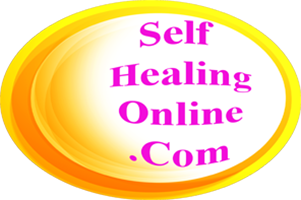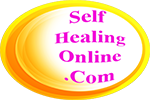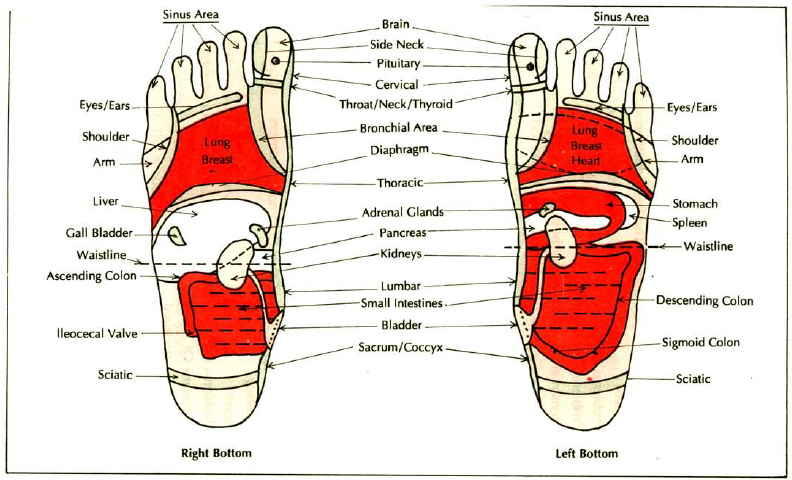Foot Reflexology
Colorpuncture
April 27, 2016Homeopathy
April 27, 2016
Reflex zone therapy or simple reflexology is a non-medicinal form of treatment in which specific spots on the surface of the body, usually the soles or palms are methodically pressed with a view to suitably influencing the internal organs of the body.
Dr. Fitzgerald divided the human body longitudinally into five zones on the left and five zones on the right. He realized that any problem of an organ lying in one particular zone could be treated by applying pressure somewhere else within the same zone.

In reflex zone therapy, the whole of each foot is methodically worked upon. However, areas or spots found tender ( painful on pressure ) are stimulated for longer periods than non-painful spots.
Reflexology treatment restores internal equilibrium. Organs and glands start working optimally and harmoniously. Reflex zone therapy also relieves mental and physical stress. Reflexology stimulates the body's immune system i.e., it strengthens the body's natural resistance. Its resistance thus strengthened, the body can prevent or drive away any disease, hence, it can be employed in any incurable disease.
Reflex zone therapy is extremely simple and any child also can learn it and can be used for self-healing. It is amazingly effective producing miraculous results. It is inexpensive and has no side effects. It can be used alone or with any conventional medicines. It can be used to preserve peak health, prevent diseases and slow down ageing process.

Zone theory is the basis of reflexology. Zones are a system for formulating relationships between various parts of the body i.e., link one part of the body to other part of the body. There are ten equal longitudinal (vertical) zones running the length of the body from the top of the head to the tips of the toes.
On soles, the zones would look as shown in fig 2.2, thus each toe is a part of one particular zone.

Zone is not a surface marking but it runs through and through the body much like an arrow piercing from the front and emerging from the back. Zones can be compared to slices of bread.

Each big toe not only represents zone 1, but in a broader sense also represents one half of the head ( all five zones).

Anything wrong in any part zone will affect the entire zone running through the whole length of the body. Sensitivity (tenderness or pain) in a specific spot on the foot, points to the fact that something is wrong somewhere in the zone (s) in which the tender spot lies.
For certain treatment of organs, specific parts of food, along the entire soles are called for stimulation i.e., treatment of lateral ( horizontal ) zones. The lateral zones help to fix the image of the body onto the feet.

The reactions of the body to Reflex Zone Therapy are classified into Local reactions and General reactions.
Local reactions are those which are produced on all organs that happen to lie in the same zone as the toe (or Longitudinal section of foot) that is stimulated.
If the little toe of the right foot is stimulated, all body and organs lying in zone R5 namely outer aspects of right foot-leg-thigh, right side of trunk, a part of large intestine, a part of liver, right side of neck, right molar teeth, right outer ear, right temple etc., are affected.
The exact nature of affects depends upon method and duration of stimulation. The alternate press-release-press-release stimulation of little toe for a short period will cause a mild stimulation of the various organs or parts of zone R5. However constant and prolonged stimulation of the same toe will gradually cause an analgesia of the organs and parts lying in this zone. Thus in the treatment that/those toe/toes or part/s of the foot is/are utilized in whose zone/s the disordered organ lies.
Reflexology believes in holistic approach to treatment. It presumes that no single organ of the body can be healthy or diseased in isolation of the rest of the body. It says that treatment should be directed not only at the diseased organ through the concerned zone but also at the entire body by working on the entire areas of both feet.
General reactions to Reflex Zone Therapy are those which are produced on the mind and the entire body that are immediate, intermediate and late reactions.
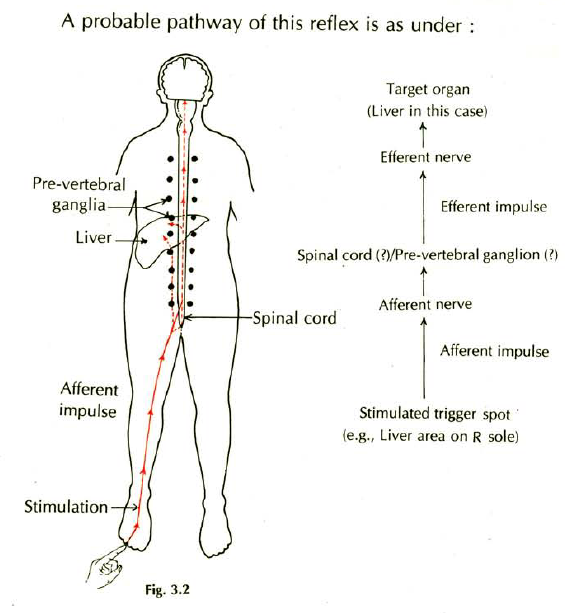
A few of the impulses generated by pressure manage to reach the hypothalamus, which is the seat of autonomous nervous system and the controller of sympatho-parasympathetic activity. The mutually opposing sympathetic parasympathetic systems then get balanced, due to which homoeostasis is restored.
There are over 7200 nerve-endings in each foot which have extensive interconnections through the spinal cord and the brain with all areas of the body.
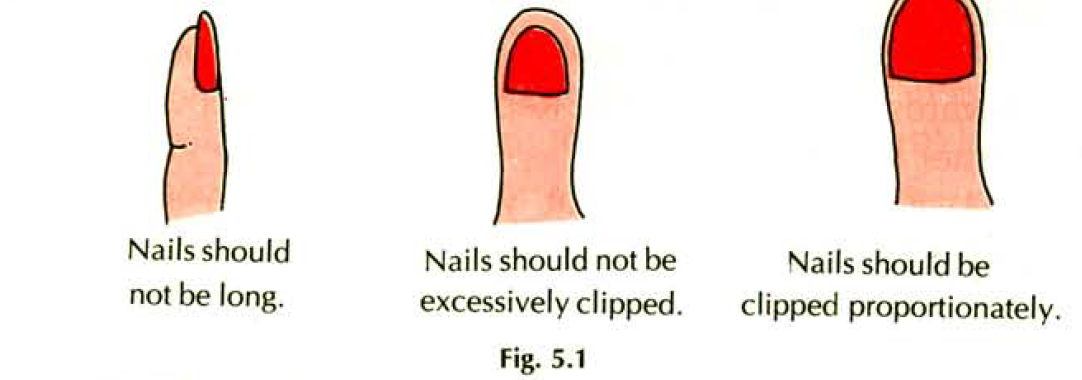
Practical Hints for healing is always keep your finger nails well trimmed to avoid injury to the skin.

Reflex Zone Therapy is given with the thumb or finger/s. Since a lot of pressure needs to be applied on the key spots of the sole, the thumb or finger soon tires and its joints start aching, but this can be avoided by simple exercises to strengthen the hands.
4.2.A:- Stand in the namaskara pose, firmly press the palms against each other for 10 counts, repeat ten times.
4.2.B:- Keep the finger-tips and thumb-tips.
4.2.C:- Forcefully bend the fingers of a hand backwards for a few seconds. Repeat ten times, repeat this for the other hand.
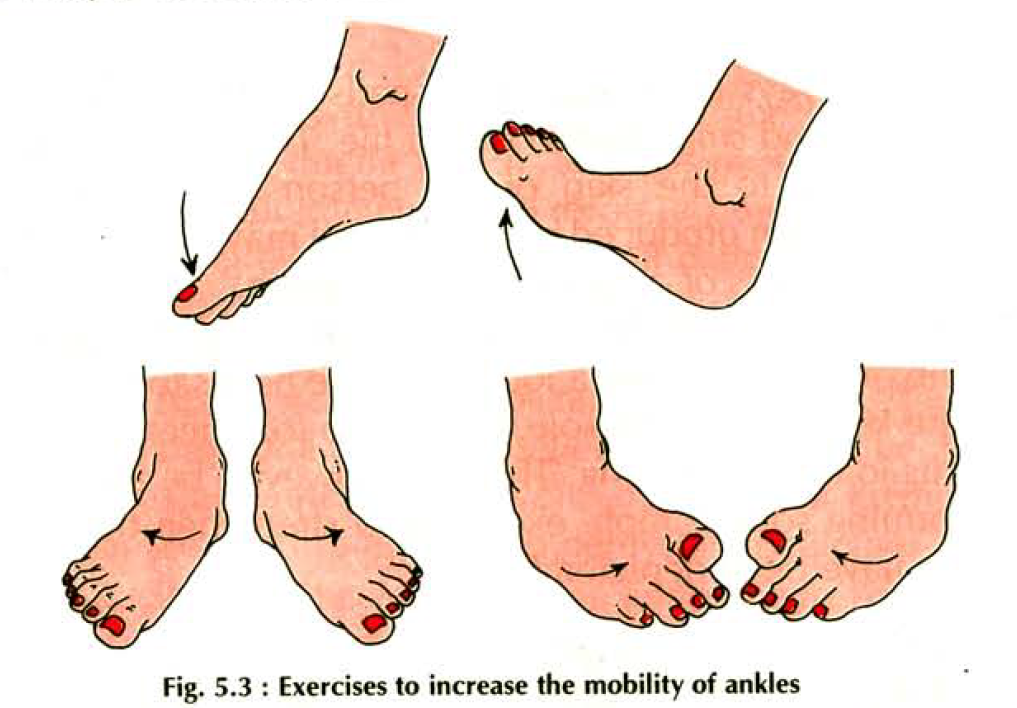
To increase the mobility of your ankle joints:-
1. the feet should be moved up and down.
2. the feet should be turned inward and outward.
Repeat each exercise ten times.

General Treatment of the Whole Body:-
Reflexology believes in a holistic approach to treatment. It contends that no organ of the body can become diseased or remain healthy in isolation of other organs. Therefore, the entire soles of both the feet should initially be stimulated for a short time, before concentrating on the specific areas related to the disordered organs. The easiest method of covering the trigger spots related to all internal organs of the body is to roll the two feet on specifically designed long wooden or plastic rollers for three to five minutes. This produces a pleasant sensation of warmth in the feet and goes a long way in restoring a state of balance (homoeostasis) inside the body.

You can wear specifically designed 'Reflexology Slippers' or insert 'Reflexology insoles' into your shoes and walk for a couple of minutes.

Generally Reflex Zone Therapy should preferably be started with the left foot, with the left foot on the right thigh.

If you are a right handed person, hold the foot with the left hand and press with the right thumb/fingers. An essential feature of treatment is to do more work with less effort, by applying the principle of leverage. This principle says that while pressing with thumb-tip, the rest of the palm and fingers should be kept in firm contact with the edge and the dorsum of the foot.

Probing the foot with your thumb, that area of the foot which corresponds with the organ you wish to treat. To cover even the most minutest part of the concerned area, employ a simple technique called 'thumb walking'.
This technique is a particular way of holding and moving the thumb. Place your thumb flat on the skin. Then slowly bend it until the portion of the thumb from the tip to the first joint reaches a vertical position in relation to the foot-surface. In this position, apply firm pressure straight in, without allowing your thumb-tip to move forward, backward or sideward. Next, release the pressure, straighten the thumb and at the same time move is forward by 1/4th of a centimeter. Then bend it again so that the tip comes in contact with an adjoining part of the concerned area.
'Walk' the thumb along the entire area corresponding to the organ you wish to treat. You will find that some spots in this area are quite sore and tender whereas others are not. Keep a mental note of all sore spots you have detected. These need special attention in the form of relatively deeper and prolonged pressure. On the other hand, less sensitive (sore) spots require only casual treatment. Deep and firm pressure can only be applied if the tip (and not the pad) of the thumb is used. For milder pressure, even the pad of the thumb can be employed.

Now take up the task of further stimulating through pressure the sore spots you have been able to detect during the process of probing. The nature of pressure could be:-
a) Alternating:- where the sore spots are pressed-released-pressed-released...., simulating a pumping action.
b) Circular:- where the skin is not is not rubbed but the tissues lying beneath the skin are rubbed.
c) Constant:- where an unrelenting pressure is given on a sore spot. When such constant pressure is continued for more than four to five minutes, analgesia of all organs lying in that particular zone sets in. This knowledge may be utilized in the treatment of such painful disorders such as headache, earache, toothache, etc. When long-term constant pressure is required, the thumb is likely to start tiring and aching. To prevent this and to make the work easier, you may use clothes-pins or rubber-bands on toes.
Precautions:-
While working do not press upon corns, callouses, injured or cracked areas and varicose veins. Instead, corresponding spots on the palms may be utilized.
After finishing pressure treatment of both the feet, take rest by lying down for 5 to 10 minutes.
In acute disorders like high fever, intense headache, acute bronchitis, etc, pressure treatment needs frequent repetition i.e., every 2 to 3 hours. The frequency may be reduced as the condition improves.
In chronic disorders, one or two treatments a day are sufficient. After 2 to 3 days of Reflex Zone Therapy, some persons especially those suffering from a chronic disease for which they have received a variety of strong, toxic medicines develop mild reactions in the form of general malaise, mild fever, running nose and sometimes skin eruptions. These are merely signs of an arousal of body-resistance and the resultant cleansing process, don't panic. These reactions subside on their own, if you take complete bed rest and abstain from taking food for some time, but continue to take therapy and consume lot of water and other liquid fluids.
The foot can be used to stimulate the body’s healing powers, the body’s own natural healing powers.
